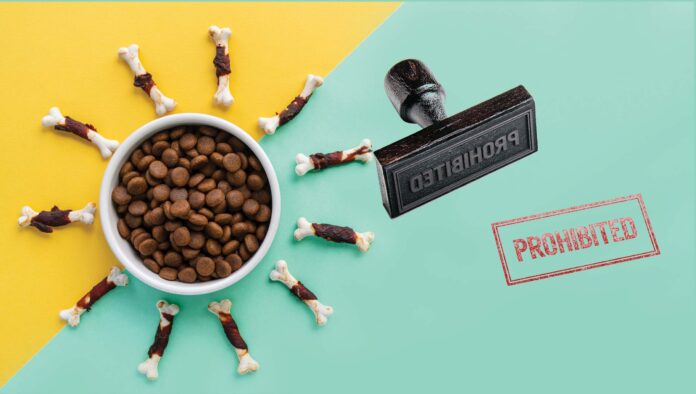There is a large shop in DHA, Lahore, chock-a-block with imported pet food and a steady stream of customers. All looks well. There seems to be no sign of the ban on imported pet food by the federal government just weeks ago.
Other markets in Lahore, Islamabad and Karachi also appear to have lots of imported pet food in stock. In fact, a cursory glance at the racks selling animal feed will have one confused. This is a far cry from the loud protests carried out by pet food traders and owners in Lahore on June 6, demanding the government lift this ban. Pet parents believe that without the availability of imported food, the health of their pets will suffer greatly, and those part of the pet food industry are scared the industry has been doomed.
Profit has set out to both investigate and to understand the issue. Where is this imported food coming from, what are the advantages and disadvantages of selling imported pet food locally, and how will this ban impact the pets’ breeding business are questions being asked.
“In the days of lockdown, pet food imports had a significant impact after which importers started buying large quantities of stocks,” says the owner of the shop in Lahore, explaining the wide array of imported foods in his store. But despite this apparent abundance, he adds that there is not much left in the market.
“The focus of the customers is mostly on three to four imported brands. In order to sell the remaining imported brands, we have to convince customers,” he explains, talking of those brands that were not in high demand in pre-Covid days, and have, therefore, been left behind in the markets.
Similarly, Rana Mubeen, a wholesaler dealing with both imported and local pet food in Samanabad, said that since the demand for imported pet food has increased significantly now many shopkeepers are even selling it in black. “We have been doing this business for the last 10 years. There is no wholesale market for this food and since it is imported and not labeled with a price, it is subject to the duties imposed on it, and its price in the international market. The price is also determined within the local market but varies from shop to shop,” he said.
“Royal Canin’s pet food is in high demand at the moment, followed by Taste of the Wild, Mera, Pedigree and many more. Pet food is not imported from just one country. If I talk about their prices, the bag of puppy food of Royal Canin which was available for PKR 1,800 two years ago has now gone up to PKR 3,000. In fact, shopkeepers have a big hand in raising prices. When news of a ban on the import of pet food came, the shopkeepers amassed a big stock and many pet owners took the big stock to their houses. Now due to higher prices, there is some reduction in demand. Customers who come to me now demand alternative pet food and sometimes buy local pet food or food imported from China.” But he talks of complaints about animals getting stomach infections from these customers, and that most seasoned pet owners still prefer to buy European pet food.
Profit also reached out to Tahir Bajwa, a major importer of pet food and president of the Pet Food Importers and Distributors Association of Pakistan. Bajwa believes that the pet food business has grown so much in Pakistan in the last three years that the field has now become an industry.
“We are the wholesalers, and the demand for local food is very low in our market which is the largest pet food market in Pakistan located in Model Town, Lahore. Now there are many reasons why this is so. The first reason is that the highest demand for dog food comes from kennels and breeders. Since they are in the business of buying and selling animals and breeding, their preference is to buy puppies and dog food that will make the puppy grow very fast with extreme quality. Now our local industry does not produce this quality food at all,” he explained. Buyers who are convinced to sell local food in their shops will always complain of customer dissatisfaction later on, he added.
When Bajwa was asked why people buy local food if the quality is not good, he referred to general ignorance in the matter. “We have a common belief that the food a cat or a dog eats with gusto is fine. But this is not the case. Dogs usually eat whatever they can find, but the cat is very delicate and sensitive in this matter. Pet food made in Pakistan and pet food imported from China or Thailand have the same quality in this regard,” he said.
The Season Group of Companies’ pet food in Pakistan, was not very successful in the beginning, he added. “Then they added a fragrance to cat food that was imported from China and was a cat’s favorite. Now cats eat that food with great pleasure but it has no result.” He also says that the company actually has its own raw material for pet products but no one can be sure of the quality. “Ingredients are also written on dog or cat food packets from China and Thailand, but in reality, it is something else. My own dogs died from eating Chinese food.”
Bajwa further explained that the blame for the increase in prices of imported pet food in the last two years, is not to be placed on the importer. “Our profit margins are very small as importers,” he explains, adding that pet food “has unfortunately been placed in the categories of luxury items. Its import taxes and duties determine its value.”
However, Wasif Ali, an official of Seasons Group of Companies, clarified to Profit that the quality of locally manufactured pet food is by no means low.
“We have a perception that there is nothing better than imported food but I will not comment on any imported food. The quality of these can be very good or very bad but if I talk about my company’s dog and cat food then its quality is very good and since the ban on imported food our demand has also increased. Our food is tested regularly and we also give our customers an open offer that they can have this food quality tested from anywhere if they want,” he said.
When Ali was asked if the increase in demand would also affect the prices of local food, he replied that it could be so because some of the vitamins and ingredients used in food have to be imported. “We haven’t raised our dog and cat food prices in a long time, but obviously if the ingredients are expensive, then we have to raise the price a little bit,” he maintained.
Similarly, Ahmed Khan, owner of local puppy and dog food, d’Amigo, which was recently launched in the Pakistani market, told Profit that the reality is that the quality of local dog food and imported dog food cannot be compared with each other.
“This does not mean that the dog food we produce is of low quality. The fact is that we are new players in the market and the companies that produce imported dog food are decades old. People have come to trust them, and of course the quality of this food has also improved with the passage of time. But if we talk about Pakistan, where was the practice of imported dog food or cat food 15 or 20 years ago? People used to feed their pets chicken, beef, bread, yogurt and vegetables and the health of the pets of that time was undoubtedly enviable. Then, with the passage of time, packaged dog and cat food came into vogue. People thought that maybe feeding this food could improve the quality of dogs and cats, and meet their nutritional needs.”
“This idea is not wrong,” he says “because packaged foods contain multivitamins and other essential nutrients for pets.” Now, with the ban, prices of imported food have gone up by 50% in the last two years. “In comparison, if we talk about local food, the ingredients are not less in it, the quality is also good and the price is also very low. I don’t know if pet food sellers have more profit in selling imported food or in selling local food but I do know that our local shopkeepers are helping us to market our products,” he said.
Khan also said that if imported food is to be completely discontinued, local food producers might also increase its price keeping in view demand, and because of rising prices in general. What is helping the situation though, is that new pet food manufacturing companies are coming up in the country, so competition will lead to competitive prices.
Having said that, he is of the view “that while people will reduce their purchases of pet food and start feeding their pets chicken or homemade food… prices will definitely change in the coming days as the cost of production of the product we are selling in the market has also increased. So maybe in the coming days its price will have to increase a little bit.”
When asked if the prices in the local industry would reduce if the ban on imports of imported pet food was lifted, Khan predicted that this would increase competition even more and the local industry would focus on further improving its quality.
“Consider for yourself that local food is much cheaper in price than imported food, and there is no veterinarian who would say that feeding local food to animals will harm their health. In a competitive race, low cost is very important,” he said.
However, Muhammad Bilal, a veterinarian practicing in Lahore, believes that while imported dog breeds may require puppy food to some extent in childhood, that does not mean survival is not possible without it.
“It is worth noting that dog and cat food is now available at many veterinary clinics,” he says, adding that a veterinarian who sells both imported and local food in his clinic will do so to earn a profit from the sales. “Many distributors also come to our clinic and encourage us to display dog and cat food but we do not,” he reveals, but they avoid doing so because of fear of defamation on social media in case the food doesn’t yield desired results.
Another aspect is that most of the problems in puppies are due to an upset stomach or viral infections, he says, and so they forbid feeding any kind of dog or puppy food. For example, vets or breeders will recommend Nestle’s Cerelac and boiled rice for puppies (puppies aged between 35 to 70 days). Some only recommend boiled boneless chicken, and some yogurt and vegetables. Every puppy is different in size, nature and structure, so it cannot be said that a puppy cannot survive unless it eats dog food (whether it is imported or local).
Therefore, he seems to believe that there is no point to the general lament. “If there is no dog or cat food available in the market, it does not mean that pets will die. It is just that pet owners will have to work harder to prepare food at home. And as for the ingredients, believe me, the multivitamin syrups or capsules that we use for ourselves can also be given to animals which have very good results. In our country, 80% of the medicines used in veterinary medicine are the same ones that are prepared for humans or children,” he said.
On the other hand, Imtiaz Shah, chairman of the Pakistan Kennel Club (PKC), and a well-known dog breeder, believes that the breeder’s business depends heavily on imported dog food.
“Look, whether it is a dog breeder or a cat, whatever litter a breeder has from his animal is its production. Now, to improve the quality of its production, he needs puppy or kitten food, which is not yet made in Pakistan. Be it Seasons Group’s dog or cat food or d’Amico’s dog food, believe me, we have tested all the samples and the quality is not good for anyone. The problem with imported dog breeds is that we can’t feed their puppies meat and if the weather in Pakistan is taken into account, even an adult dog or cat cannot be fed beef in the summer,” he explained.
The issue of the burden of tax falling solely on the importer is yet another troubling aspect for the business. When questioned about breeders who sell dogs at high prices, evading taxes, Shah emphatically denied it being so.
“There are approximately 40-45 dog and cat food importers in Pakistan and more than 150 types of food are imported into Pakistan. The importer then puts the entire tax burden on the buyer or the pet owner,” he says. Therefore, in a way, the breeder is paying all kinds of taxes on the purchase of dog or cat food. Secondly, there are more than a thousand kennels registered in our club. Dog breeding is an industry all over the world but it is not the same here, as yet. We strongly support the idea that if someone is making money from dog breeding, they should also pay taxes, but it is also important that the government give it industry status,” he added.
When Shah was asked if the ban on dog food would affect breeders’ businesses, Shah replied that in Pakistan, just like when there is news of a petrol price hike, people line up at petrol pumps, in this case too, breeders and pet owners stockpiled for six months when news of the ban spread. “They still have the stock,” he adds.
However, another dog and cat breeder, Hamza Khan, disagrees and believes that overall inflation and the rise in the price of pet food have affected the breeders’ business.
“Until last year, people were more inclined to keep pets. We are dog and cat breeders.
We have rare breeds of dogs including German Shepherd, Labrador, Rottweiler, Dober Man, Siberian Husky. Similarly, we breed different breeds of cats. Last year the price of long coat pedigree puppies ranged from PKR 80,000 to PKR 120,000 and this year we sold better quality puppies for only PKR 60,000 to PKR 70,000. Because every customer said that their [puppies and kittens] food and vaccinations have become expensive. The Labrador puppy used to sell for PKR 25,000 to PKR 40,000 but is now being sold in the market for RS 10,000. Some breeders have started distributing cats for free because they can’t afford it themselves and the customer is not ready to buy. Business slows down a bit in the summer, but people’s purchasing power is also declining,” he said.
People used to give chicken to their pets as an alternative to imported food but that too, has become expensive now. Oatmeal, rice, vegetables, yogurt, milk, bread – everything is expensive now. Inflation has had a major impact on this business and will continue to do so in the future.

























Is it harmful for economy?
I dеfinitely loved every little bit of it and I have you book marked too check .
온라인 카지노
j9korea.com